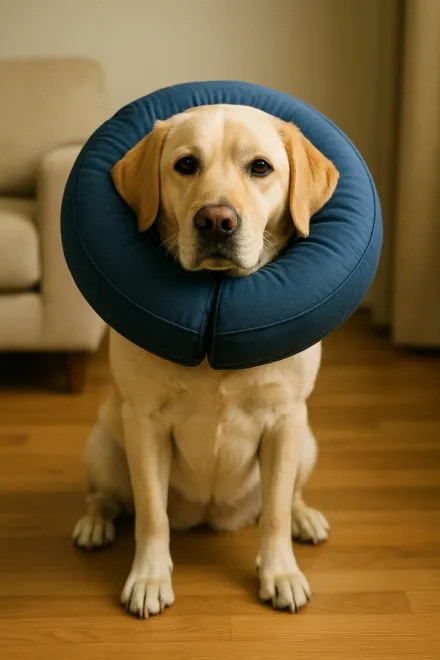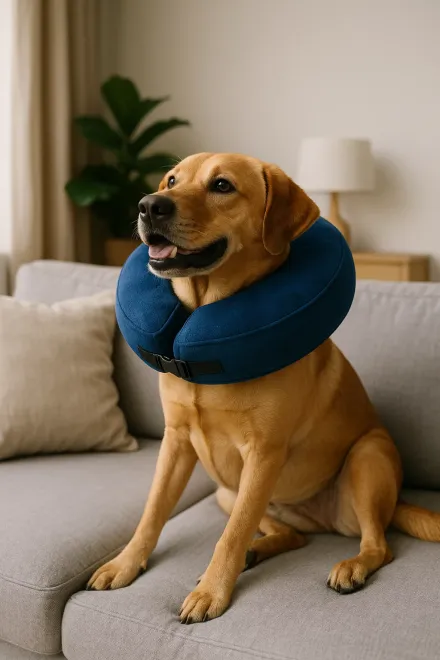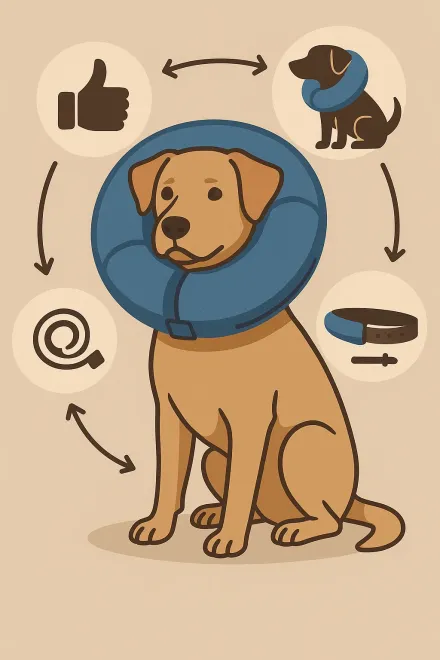Inflatable Dog Recovery Collar
The inflatable dog recovery collar is a modern and much more comfortable alternative to the traditional rigid plastic cone. Its main function is to prevent the pet from licking, biting, or scratching sensitive areas of the body during recovery after surgery, wounds, or skin conditions. Unlike the classic Elizabethan collar, this padded and inflatable model allows the dog to move more freely, rest without discomfort, and maintain a calmer lifestyle during convalescence. Thanks to its ergonomic and lightweight design, more and more vets and owners recommend it as an effective and less stressful option for post-operative care.
Discover the best inflatable dog recovery collars on Amazon
What is an inflatable dog recovery collar?
An inflatable dog recovery collar serves the same purpose as the classic rigid cone: preventing the pet from accessing wounds, stitches, dermatitis areas, or bandages. The difference lies in its design. This model consists of an inflatable ring covered with soft materials that fits around the dog's neck. When inflated, it creates a barrier that limits the muzzle's movement without completely blocking vision or mobility.
Thanks to its padded structure, the dog can rest its head comfortably, drink water, and eat with greater ease. It also significantly reduces anxiety since it does not create the same level of isolation as rigid plastic collars. It is especially recommended for nervous or sensitive dogs and for owners looking for a less invasive way to ensure safe recovery.
Advantages of inflatable recovery collars for dogs
The inflatable dog recovery collar has gained popularity because it greatly improves the recovery experience compared to the rigid cone. Its main benefits include:
- More comfort: its padded surface prevents chafing and neck injuries.
- Improved mobility: allows the dog to walk, climb stairs, or lie down without bumping into furniture.
- Less stress: the dog keeps part of its peripheral vision, which reduces anxiety.
- Sleep-friendly design: the inflatable shape makes it easier for the dog to rest its head naturally.
- Easy storage and cleaning: as it is inflatable, it deflates and takes up very little space; most models also come with washable covers.
These advantages make many owners see it as the best option for recovery, although in specific cases, such as wounds on front legs or hard-to-restrict areas, the rigid cone may still be more effective. Nevertheless, for most dogs, the inflatable version is the ideal alternative.


How to choose the right inflatable recovery collar for your dog
Choosing the ideal inflatable dog recovery collar depends on several factors that ensure both effectiveness and comfort for the pet. Consider the following points:
- Size and fit: each model has specific measurements. Measure your dog's neck circumference and compare it with the manufacturer's guide.
- Durability: look for resistant materials, especially if your dog tends to chew objects.
- Compatibility with regular collar: some models include loops to pass through the standard collar for a more secure fit.
- Ease of inflation: choose options with safe valves that hold air without leaks.
- Breed and morphology: for dogs with long muzzles or very agile breeds, this type of collar may not be enough to prevent access to certain areas.
In conclusion, the key is to choose the right size and a model suited to your dog's behavior and physical characteristics. That way, it will be effective and comfortable at the same time.
Frequently asked questions about inflatable dog recovery collars
Is the inflatable recovery collar as effective as the rigid one?
The inflatable dog recovery collar is very effective in most cases, as it prevents the dog from licking or biting sensitive areas. However, it does not always replace the rigid one 100%. For wounds on front legs, torso, or very accessible areas, the rigid collar provides more security. That is why it is advisable to consult your vet and evaluate which option is best depending on the wound location and the dog's behavior.
Can I leave my dog alone with the inflatable recovery collar?
Yes, in most cases you can leave your dog alone with the inflatable recovery collar as long as you have previously checked that it cannot remove it or reach the protected area. It is advisable to supervise during the first hours of use to ensure the dog tolerates it well. Once confirmed, it can be worn safely during the owner's usual absences.
What size inflatable recovery collar should I buy?
The size depends on your dog's neck circumference and, in some cases, weight. Ideally, measure the neck with a tape measure and check the sizing chart provided by each manufacturer. Buying the correct size is essential, as a collar that is too loose may allow access to the wound, while one that is too tight may cause discomfort or breathing difficulties.
Can dogs sleep with the inflatable recovery collar?
Yes, in fact, one of the main advantages of the inflatable recovery collar is that it allows the dog to sleep more comfortably. Being padded, it can rest its head without discomfort, unlike the rigid cone which is often uncomfortable for resting. This contributes to a calmer recovery with less stress for the pet.
Can an inflatable recovery collar be washed?
Most inflatable dog recovery collars come with removable, washable covers. This keeps it clean and hygienic throughout the recovery period. If it does not have a cover, it can be cleaned with a damp cloth and mild soap. Keeping the collar clean is essential to prevent odors and bacteria buildup.
Are inflatable recovery collars suitable for all dog breeds?
They work very well for most breeds, especially those with short or medium muzzles. However, for dogs with very long muzzles, such as greyhounds or dobermans, or very agile breeds, the inflatable collar may not be enough to prevent them from reaching certain areas. In such cases, the rigid cone may be more suitable.
How do you inflate and deflate an inflatable recovery collar?
The process is simple: just open the valve and blow until the ring is firm, but not over-inflated. To deflate, simply open the valve and press until all the air is out. Some models come with safety valves that make the process easier and prevent leaks. It is recommended to check periodically for air loss.
